Fattorini H.O., Kerber A. The Cauchy Problem
Подождите немного. Документ загружается.

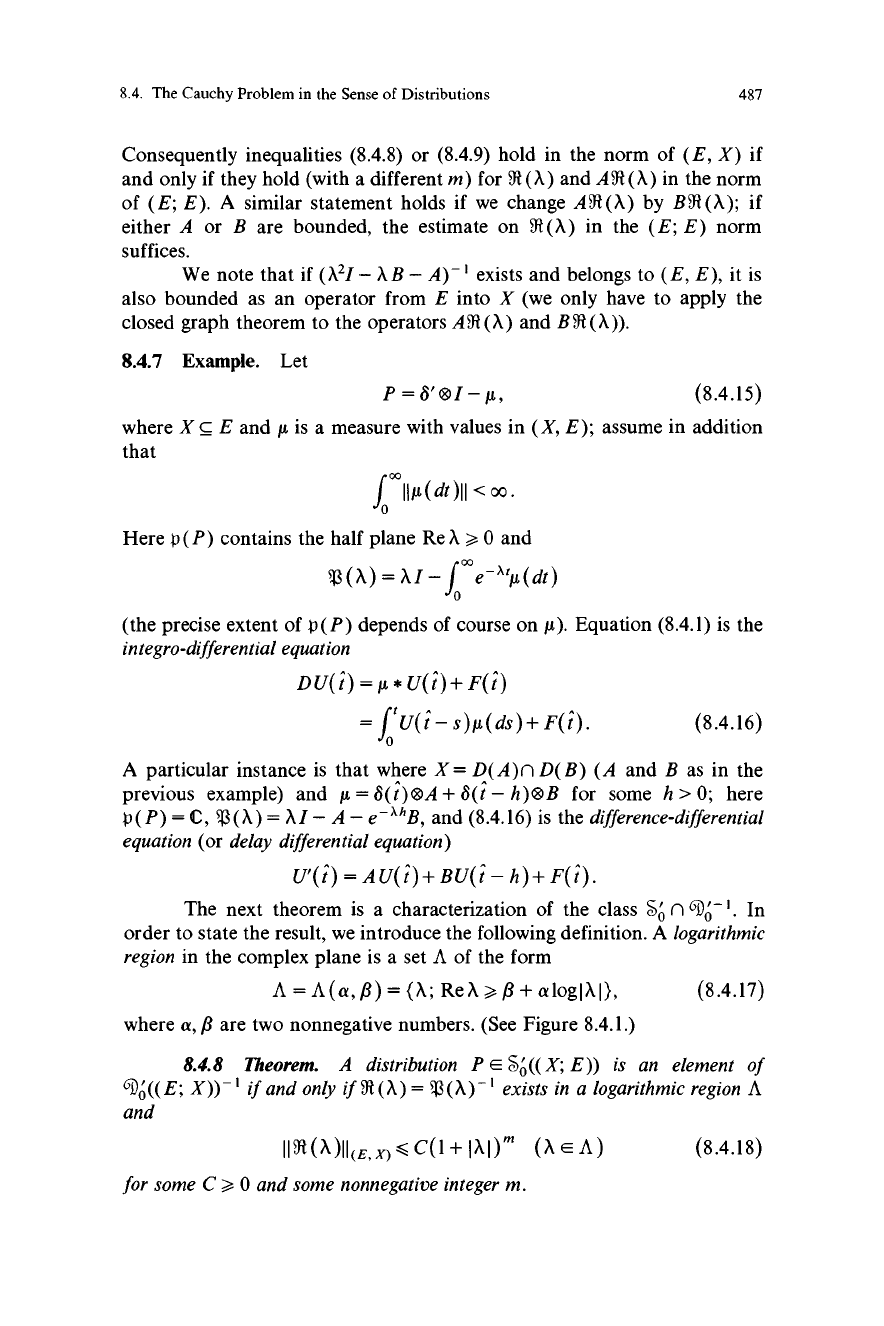
8.4. The Cauchy Problem in the Sense of Distributions
487
Consequently inequalities (8.4.8) or (8.4.9) hold in the norm of (E, X) if
and only if they hold (with a different m) for 91(A) and A 91(X) in the norm
of (E; E). A similar statement holds if we change A 9t (A) by B 9t (X); if
either A or B are bounded, the estimate on 91(X) in the (E; E) norm
suffices.
We note that if (X2I - AB - A)-' exists and belongs to (E, E), it is
also bounded as an operator from E into X (we only have to apply the
closed graph theorem to the operators A 91 (A) and B 9t (X)).
8.4.7
Example. Let
P=8'®I-µ, (8.4.15)
where X C_ E and µ is a measure with values in (X, E); assume in addition
that
f °°Ilµ(dt)II <oo.
Here P (P) contains the half plane Re A >, 0 and
(A) = AI - f
Ce-srµ(dt)
0
(the precise extent of p(P) depends of course on µ). Equation (8.4.1) is the
integro-differential equation
DU(t)=µ*U(t)+F(t")
=
f`U(t-s)µ(ds)+F(t).
(8.4.16)
0
A particular instance is that where X = D(A) n D(B) (A and B as in the
previous example) and µ = S(t)®A+ S(t - h)®B for some h > 0; here
p(P) = C, $(A) = Al - A - e-""B, and (8.4.16) is the difference-differential
equation (or delay differential equation)
U'(t)=AU(t)+BU(t-h)+F(t).
The next theorem is a characterization of the class 50 1 n 6 '-. In
order to state the result, we introduce the following definition. A logarithmic
region in the complex plane is a set A of the form
A=A(a,/3)=(A; ReA>/3+alogIN1),
(8.4.17)
where a, /3 are two nonnegative numbers. (See Figure 8.4.1.)
8.4.8 Theorem. A distribution P E 5o((X; E)) is an element of
6D' ((E; X)) if and only if 9t (A) (A) -' exists in a logarithmic region A
and
II91(A)II(E,x)
C(1+IAI)'n
(AE=-A) (8.4.18)
for some C >, 0 and some nonnegative integer m.
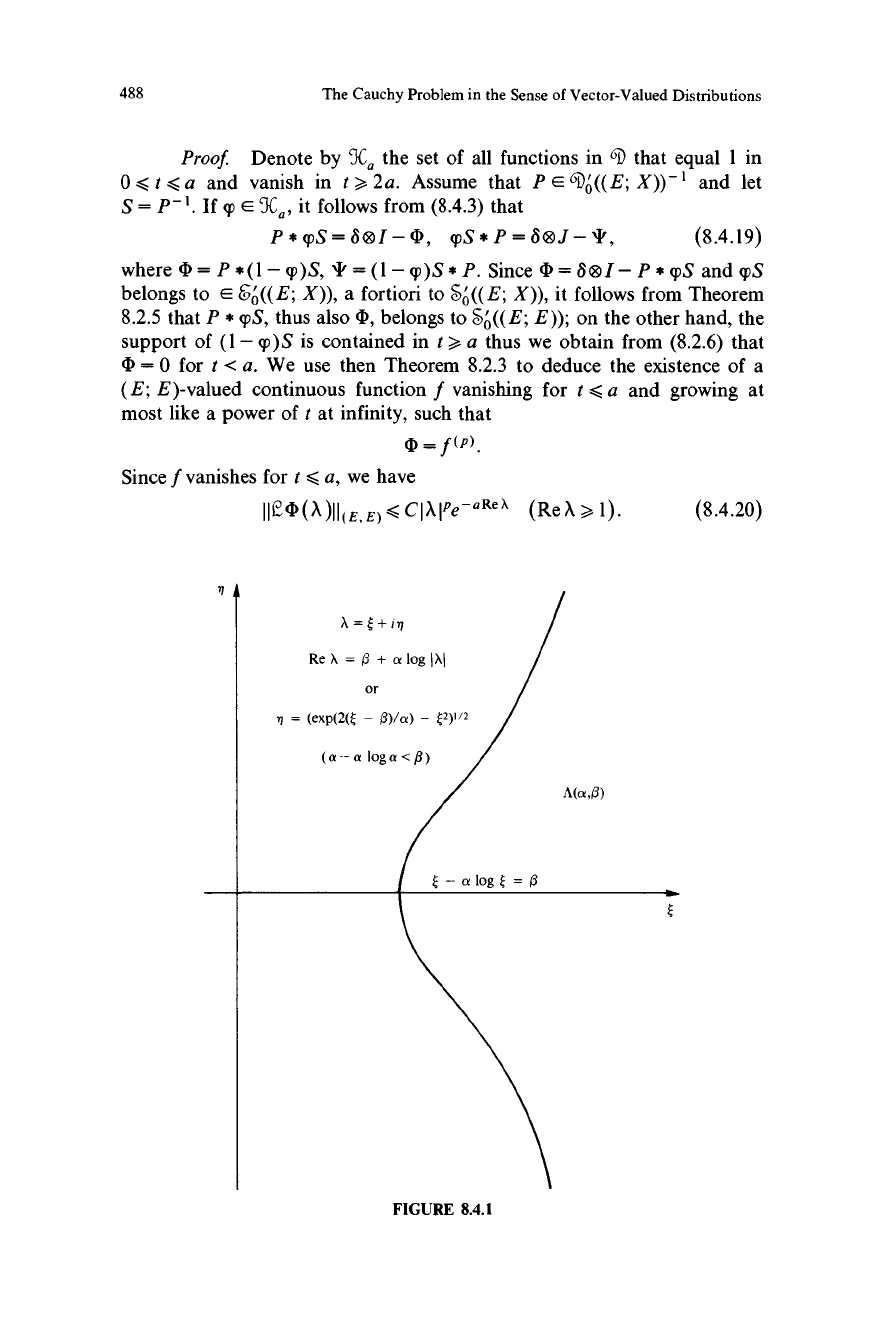
488
The Cauchy Problem in the Sense of Vector-Valued Distributions
Proof. Denote by JCa the set of all functions in 6D that equal 1 in
0 < t < a and vanish in t >, 2a. Assume that P E 6) o((E;
X))- 1
and let
S = P-1. If T E 3Ca, it follows from (8.4.3) that
P*4pS=8®I- I, qpS*P=6®J-4Y,
(8.4.19)
where 4D=P*(1-T)S, 4'=(1-q))S*P. Since c=S(&I-P*q)S and pS
belongs to E to((E; X)), a fortiori to 50'((E; X)), it follows from Theorem
8.2.5 that P * q)S, thus also (D, belongs to S,0 '((E; E)); on the other hand, the
support of (1- qp)S is contained in t > a thus we obtain from (8.2.6) that
(D = 0 for t < a. We use then Theorem 8.2.3 to deduce the existence of a
(E; E)-valued continuous function f vanishing for t < a and growing at
most like a power of t at infinity, such that
iD = f(P).
Since f vanishes for t < a, we have
IIF-(D(X)11(E.E)<C'jXjPe-aRe11
(ReX
1). (8.4.20)
ReA=/3+alogJXJ
or
rl = (exp(2(?; - 0)/a) - t2)1/2
(a -- a Toga</3)
A(a,/3)
0
E
FIGURE 8.4.1
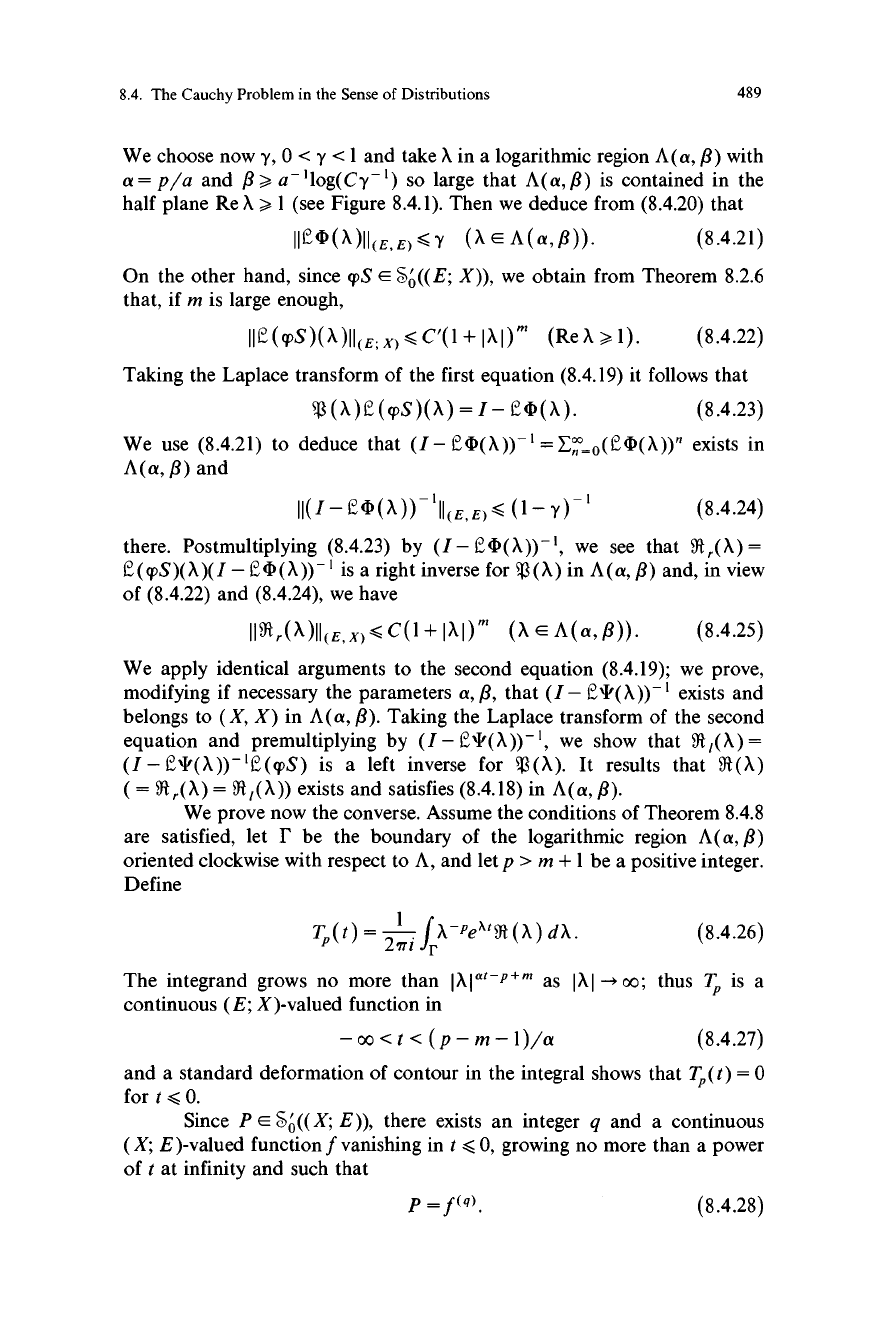
8.4. The Cauchy Problem in the Sense of Distributions
489
We choose now y, 0 < y < 1 and take N in a logarithmic region A(a, /3) with
a=p/a and /3, a-'log(Cy-') so large that A(a,/3) is contained in the
half plane Re X ,1 (see Figure 8.4.1). Then we deduce from (8.4.20) that
IIA)(X)II(E,E)<y
(XEA(a,$)).
(8.4.21)
On the other hand, since cpS E 50'((E; X)), we obtain from Theorem 8.2.6
that, if m is large enough,
IIe(TS)(t)II(E;X)<C'(1+IxI)m (ReX,1).
(8.4.22)
Taking the Laplace transform of the first equation (8.4.19) it follows that
$(X)E(00)=I-L(D(A).
(8.4.23)
We use (8.4.21) to deduce that (I - 1(X)) ' = E
A(a, /3) and
(b 1(X))" exists in
II(I-e (X))-'II(E
E)<(1-y)
(8.4.24)
there. Postmultiplying (8.4.23) by (I - '(X)) ', we see that 9i,(X) _
L(()S)(X)(I- L)(X))-' is a right inverse for $(X) in A(a, /3) and, in view
of (8.4.22) and (8.4.24), we have
IIR,(X)II(E,X)<C(1+IXI)m
(XEA(a,Q)).
(8.4.25)
We apply identical arguments to the second equation (8.4.19); we prove,
modifying if necessary the parameters a, /3, that (I -
exists and
belongs to (X, X) in A (a, /3 ). Taking the Laplace transform of the second
equation and premultiplying by (I - e we show that 31,(X) _
is a left inverse for $(X). It results that 91(X)
91r(A) = 9,(X)) exists and satisfies (8.4.18) in A(a, /3).
We prove now the converse. Assume the conditions of Theorem 8.4.8
are satisfied, let r be the boundary of the logarithmic region A(a, /3)
oriented clockwise with respect to A, and let p > m + 1 be a positive integer.
Define
Tp(t)
2I f
X-PeXt91(A)dX. (8.4.26)
7ri
r
The integrand grows no more than
I
at-P+m
as IX -> cc; thus TP is a
continuous (E; X)-valued function in
-o0<t<(p-m-1)/a
(8.4.27)
and a standard deformation of contour in the integral shows that TP (t) = 0
fort<0.
Since P E 50'((X; E)), there exists an integer q and a continuous
(X; E )-valued function f vanishing in t < 0, growing no more than a power
of t at infinity and such that
P = f (9). (8.4.28)
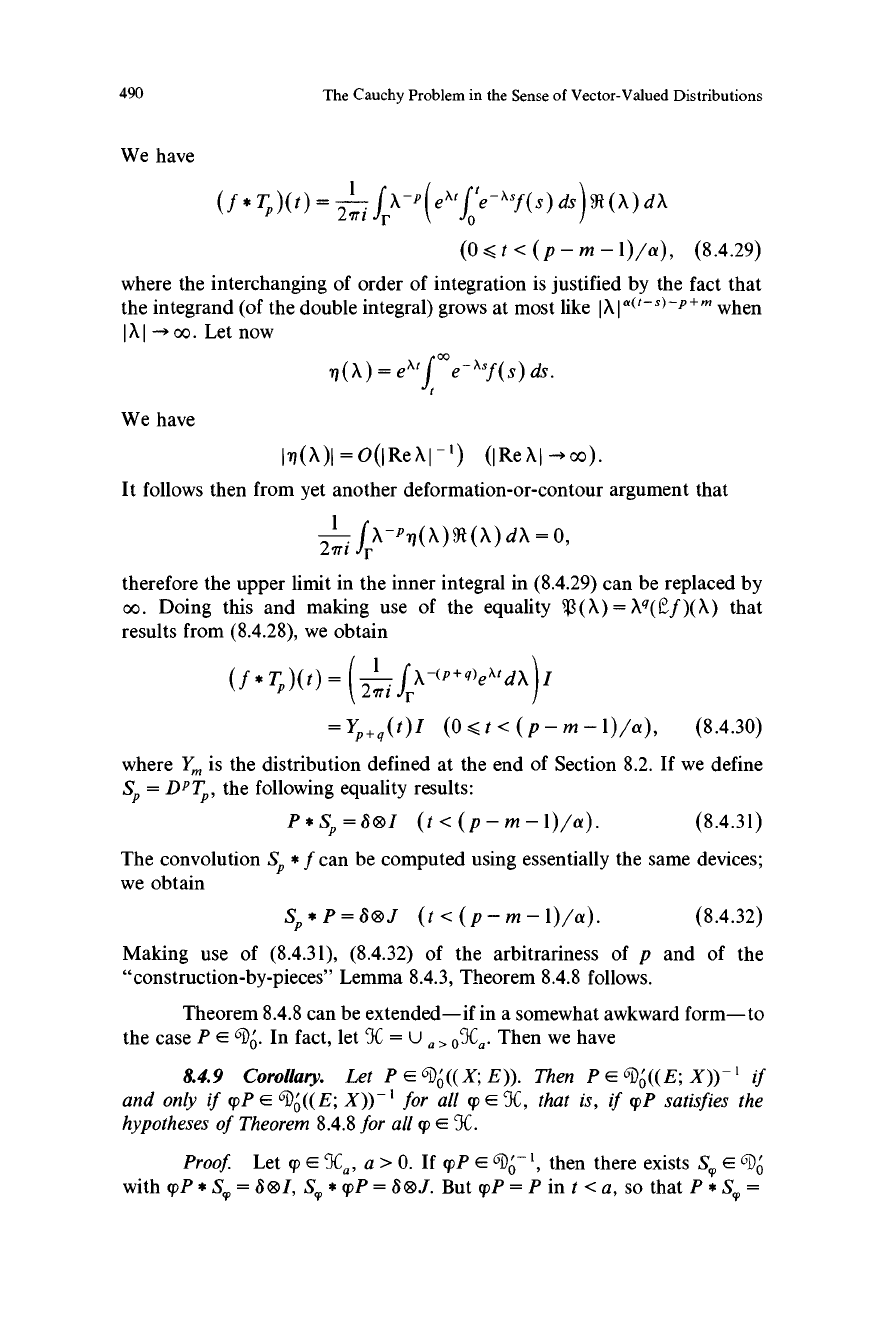
490
The Cauchy Problem in the Sense of Vector-Valued Distributions
We have
(f*TP)(t)=
JrX-Peat f`e-"sf(s)ds)91(X)A
(0 < t < (p - m - 1)/a), (8.4.29)
where the interchanging of order of integration is justified by the fact that
the integrand (of the double integral) grows at most like IAIa(t-s)-P+m when
I X I -f oo. Let now
n (X) = estf
°°e-'s f(s) ds.
We have
(IReXI-*oo).
It follows then from yet another deformation-or-contour argument that
1 f
2iri r
therefore the upper limit in the inner integral in (8.4.29) can be replaced by
oo. Doing this and making use of the equality $ (X) = Aa(L f)(X) that
results from (8.4.28), we obtain
(f *TP)(t) _
(_fxeX1dx)I
21ri
YP+q(t)I (0<t<(p-m-1)/a), (8.4.30)
where Ym is the distribution defined at the end of Section 8.2. If we define
SP = DPTP, the following equality results:
P*SP=S®I (t<(p-m-l)/a).
(8.4.31)
The convolution SP * f can be computed using essentially the same devices;
we obtain
SP*P=S®J (t<(p-m-l)/a).
(8.4.32)
Making use of (8.4.31), (8.4.32) of the arbitrariness of p and of the
"construction-by-pieces" Lemma 8.4.3, Theorem 8.4.8 follows.
Theorem 8.4.8 can be extended-if in a somewhat awkward form-to
the case P E 6 Do. In fact, let X = U
OX, Then we have
8.4.9 Corollary. Let P E 610'((X; E)). Then P E 6D ((E; X))-' if
and only if 4pP E 6%((E; X))
for all qq E'JC, that is, if pP satisfies the
hypotheses of Theorem 8.4.8 for all 99 E C.
Proof
Let p E Xa, a > 0. If pP E 61. o-', then there exists Sp E 610
with q)P*SP =B®I, Sq, *q7P=S®J. But(pP=Pint<a, so that P*S1,=
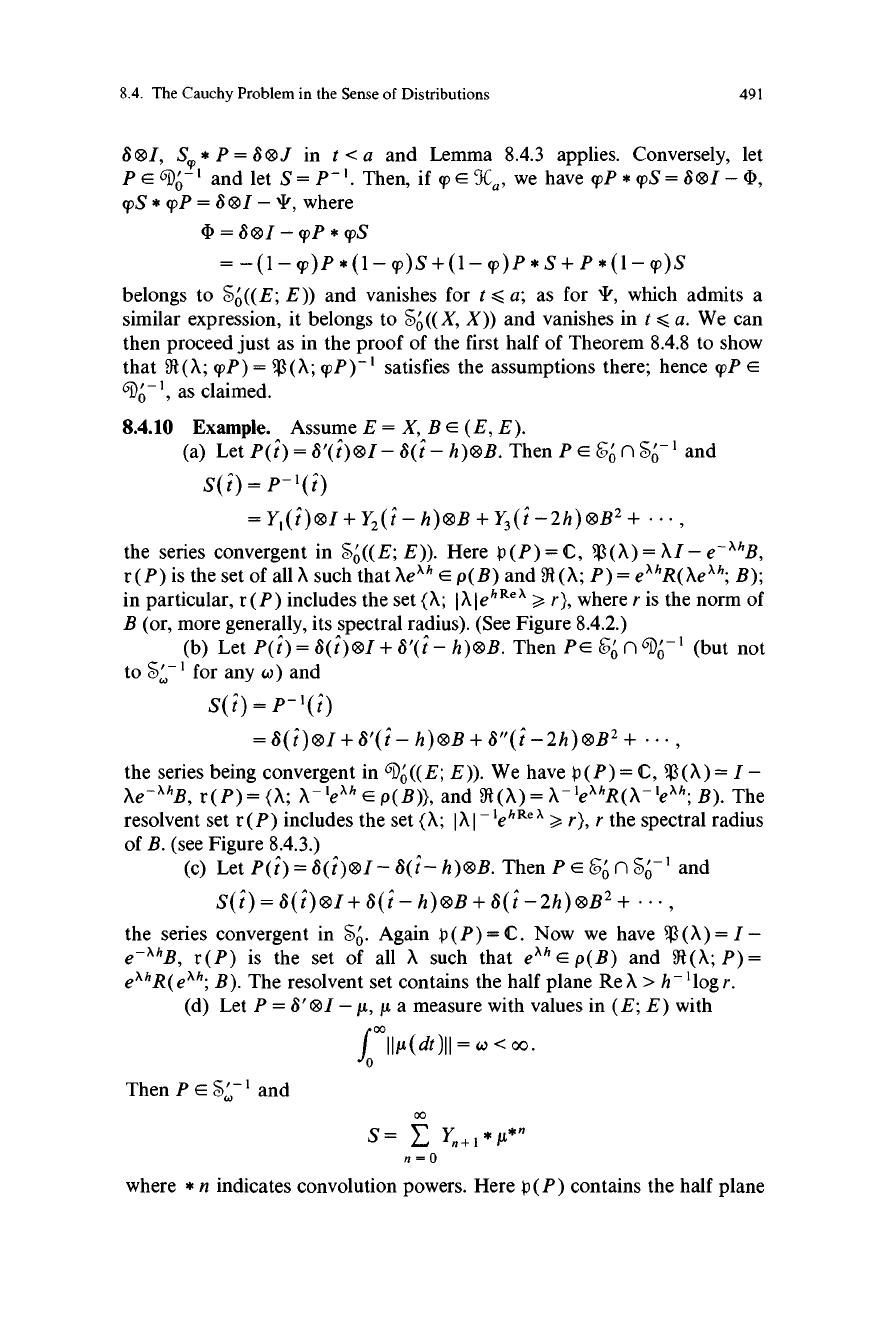
8.4. The Cauchy Problem in the Sense of Distributions
491
S ®I, ST * P = S (& J in t < a and Lemma 8.4.3 applies. Conversely, let
P E 6l-'
o
and let S = P-'. Then, if (P E 9Cu, we have q)P * TS = S®I - 0,
q)S * pP = S ®I - 4', where
0=S®I-q)P*pS
=-(1-q1)P*(l-rp)S+(l-p)P*S+P*(1-p)S
belongs to 50((E; E)) and vanishes for t < a; as for which admits a
similar expression, it belongs to S' ((X, X)) and vanishes in t < a. We can
then proceed just as in the proof of the first half of Theorem 8.4.8 to show
that 31 (A; pP) = $ (A; q?P) -' satisfies the assumptions there; hence cpP E
6D'-', as claimed.
8.4.10 Example. Assume E = X, B E (E, E).
(a) Let P(t) = 8'(i) 01 - S(t - h)®B. Then P E o n So-' and
S(i) = P-'(t")
=Y1(t)®I +Y2(i - h)®B + Y3(i -2h)®B2 +
the series convergent in So((E; E)). Here P (P) = C, 3(A) = Al - e-XhB,
r(P) is the set of all A such that AeXh e p(B) and 91 (X; P) = eAhR(AeXh; B);
in particular, r (P) includes the set (A;
I A I e h Re a >, r), where r is the norm of
B (or, more generally, its spectral radius). (See Figure 8.4.2.)
(b) Let P(t) = 8(t)®I + S'(t - h)®B. Then PE fo n 6Do-' (but not
to Sw ' for any w) and
S(t) = P-'(t)
=8(t)®I+8'(i-h)®B+8"(t-2h)®B2+
the series being convergent in 61. ' ((E; E)). We have p (P) = C, (A) = I -
Ae-11hB r(P) = (A; A-'ex' E p(B)), and 91(A) = A-leXhR(A-'euh; B). The
resolvent set r (P) includes the set (A;
I A I -'e h Re a >, r), r the spectral radius
of B. (see Figure 8.4.3.)
(c) Let P(t) = S(t)(&I - S(t- h)®B. Then P E n S' ando o
S(t)=S(t)®I+S(t"- h)®B+S(t-2h)®B2+
,
the series convergent in So. Again P (P) = C. Now we have $ (A) = I -
e-XhB, r(P) is the set of all A such that eXh E=-p(B) and 1t(A; P) =
eXhR(eXh; B). The resolvent set contains the half plane Re A > h-'log r.
(d) Let P = 8'(& I - p, µ a measure with values in (E; E) with
f llµ(dt)Il=w<oo.
Then P E Sw ' and
00
S=
Y+t*µ*n
n=0
where * n indicates convolution powers. Here P (P) contains the half plane

492
The Cauchy Problem in the Sense of Vector-Valued Distributions
n
),IeAReX = r
or
(r2e-2ht - 2)1/2
leht = r
r(P)
FIGURE 8.4.2
Re X >- 0 and
s(X)=xI-f e-atµ(dt)
=a(I- f 00e->,tµ(dt))
o
Accordingly r(P) contains the set of all A /for which
Ill
<1
and
I
'(-f-e-"µ(dt))n
for those X.
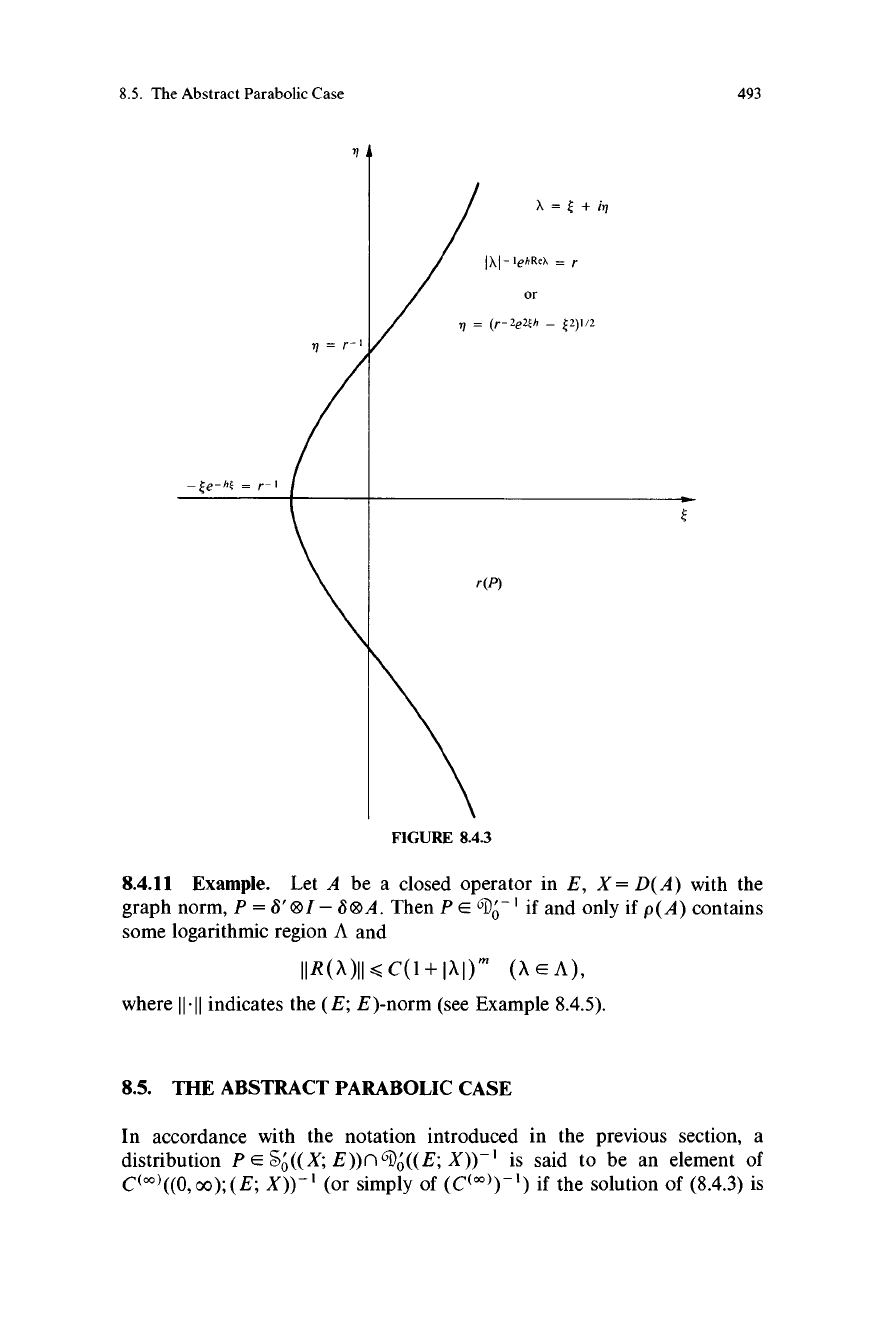
8.5. The Abstract Parabolic Case
493
v
X=E+hi
IXI-iehaeX = r
n = r-I
- te- ht = r-I
or
)1 =
(r-2e2th
-
2)1/2
r(P)
FIGURE 8.4.3
E
8.4.11 Example.
Let A be a closed operator in E, X = D(A) with the
graph norm, P = 8'(& I - 8 ®A. Then P E 6D'-' if and only if p (A) contains
some logarithmic region A and
IIR(X)II<C(1+IXI)'n (XEA),
where I I' I I indicates the (E; E)-norm (see Example 8.4.5).
8.5. THE ABSTRACT PARABOLIC CASE
In accordance with the notation introduced in the previous section, a
distribution P E 50'(( X; E))r)6D ((E; X))
is said to be an element of
C(°°)((0,oo);(E; X)) -' (or simply of (C(°°)) if the solution of (8.4.3) is
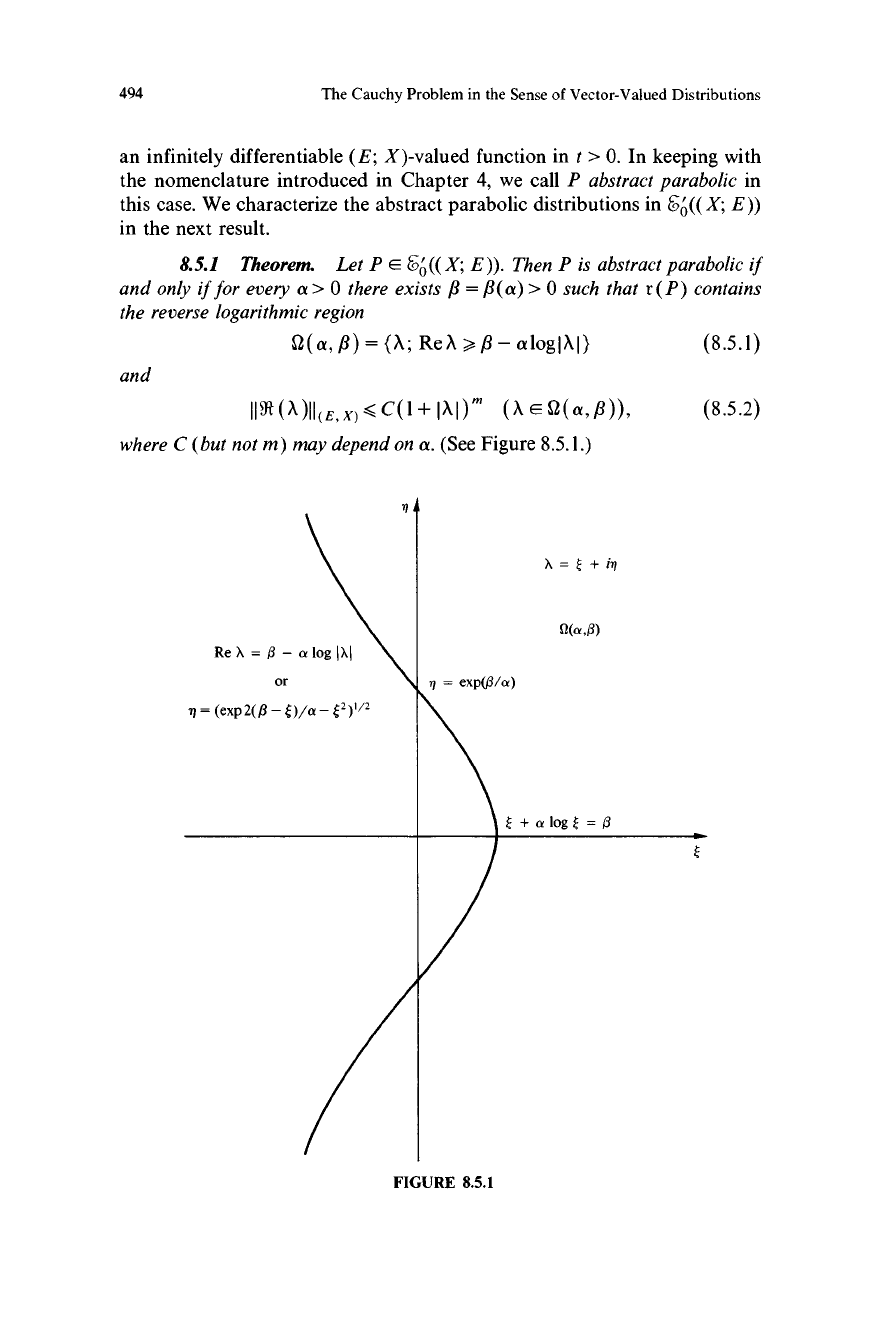
494
The Cauchy Problem in the Sense of Vector-Valued Distributions
an infinitely differentiable (E; X)-valued function in t > 0. In keeping with
the nomenclature introduced in Chapter 4, we call P abstract parabolic in
this case. We characterize the abstract parabolic distributions in &;o((X; E))
in the next result.
8.5.1 Theorem. Let P E 6;0'((X; E)). Then P is abstract parabolic if
and only if for every a > 0 there exists /3 = /3(a) > 0 such that r (P) contains
the reverse logarithmic region
2(a,/3)=(X; ReX>/3-alogIXI)
(8.5.1)
and
where C (but not m) may depend on a. (See Figure 8.5.1.)
ReX=(3-ologjXI
p
ort
t
r1=(eXp2(Q-S)/a-f2)1/z
= exp(/3/a)
9(a,Q)
f+alog f=/3
FIGURE 8.5.1
(8.5.2)
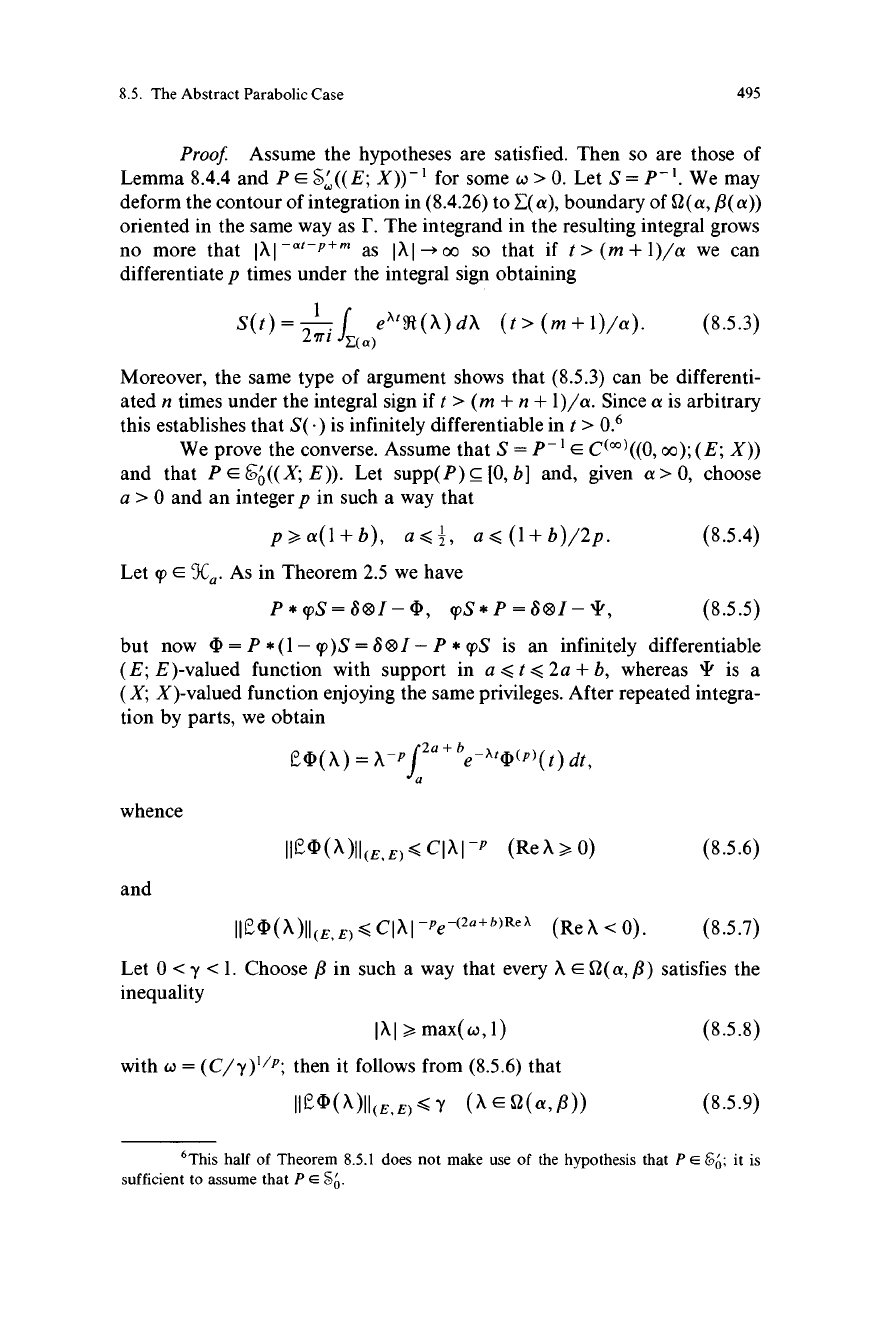
8.5. The Abstract Parabolic Case
495
Proof. Assume the hypotheses are satisfied. Then so are those of
Lemma 8.4.4 and P E S.((E; X))-' for some w > 0. Let S = P. We may
deform the contour of integration in (8.4.26) to E(a), boundary of S2 (a, #(a))
oriented in the same way as I'. The integrand in the resulting integral grows
no more that IXI
-at-p+m
as IXI - oo so that if t > (m + 1)/a we can
differentiate p times under the integral sign obtaining
S(t)= 1. f
eAt R(X)dX (t> (m+l)/a).
(8.5.3)
27x1
E(a)
Moreover, the same type of argument shows that (8.5.3) can be differenti-
ated n times under the integral sign if t > (m + n + 1)/a. Since a is arbitrary
this establishes that
is infinitely differentiable in t > 0.6
We prove the converse. Assume that S = P-' e C(°°)((0, oo); (E; X))
and that P E 60 '((X; E)). Let supp(P) c [0, b] and, given a > 0, choose
a > 0 and an integer p in such a way that
p>a(1+b), a<'-2, a<(1+b)/2p. (8.5.4)
Let rp E Xa. As in Theorem 2.5 we have
P*q)S=8®I-4D, q9S*P=8®I-41,
(8.5.5)
but now (D= P *(1- q))S = S®I - P * TS is an infinitely differentiable
(E; E )-valued function with support in a < t < 2 a + b, whereas 4, is a
(X; X)-valued function enjoying the same privileges. After repeated integra-
tion by parts, we obtain
LA(X) = x-p f
2a+be-xt(D(p)(t)
dt,
whence
IIL(D(A)II(E,E)<CIXI-p
(ReX
0) (8.5.6)
and
IIL")
(A)II(E,E)<CIXI-pe-(2a+b)Re?
(ReA<0).
(8.5.7)
Let 0 < y < 1. Choose /3 in such a way that every X E 0 (a, $) satisfies the
inequality
I X I % max(co,1)
with w = (C/y)'/p; then it follows from (8.5.6) that
IIL'D(x)II(E,E)<y
(XEQ(a,$))
(8.5.8)
(8.5.9)
6This half of Theorem 8.5.1 does not make use of the hypothesis that P E &o; it is
sufficient to assume that P E 5o.
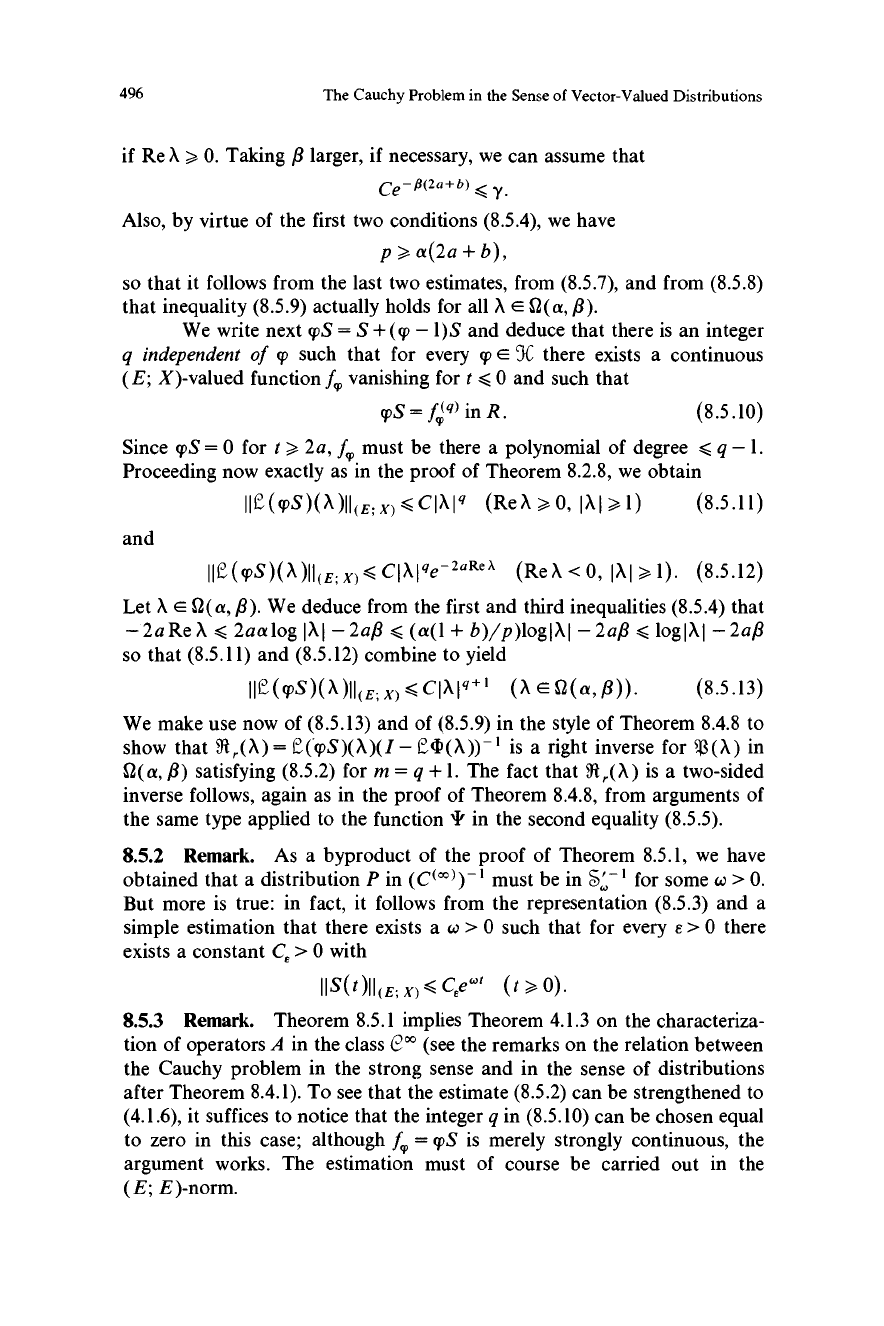
496
The Cauchy Problem in the Sense of Vector-Valued Distributions
if Re A > 0. Taking /3 larger, if necessary, we can assume that
Ce-,8(2a+e)
< Y.
Also, by virtue of the first two conditions (8.5.4), we have
p > a(2a + b),
so that it follows from the last two estimates, from (8.5.7), and from (8.5.8)
that inequality (8.5.9) actually holds for all A E SZ (a, fl).
We write next qpS = S +((p -1)S and deduce that there is an integer
q independent of 9D such that for every (p E 3C there exists a continuous
(E; X)-valued function f9, vanishing for t < 0 and such that
q?S = f(q)
in R. (8.5.10)
Since pS = 0 for t > 2a, f! must be there a polynomial of degree < q - 1.
Proceeding now exactly as in the proof of Theorem 8.2.8, we obtain
IIe (ms)(X)II(E; X) <clXl4 (ReX 0, ICI ,1)
(8.5.11)
and
IIe(gS)(A)II(E;X)<CINIge-zaRea
(ReX<0, IXI>1).
(8.5.12)
Let A E 2(a, /3). We deduce from the first and third inequalities (8.5.4) that
-2a Re X < 2aa log IXI - 2a/3 < (a(1 + b)/p)loglXI - 2a/3 < loglXI - 2a/3
so that (8.5.11) and (8.5.12) combine to yield
Ile(9)s)(x)II(E;x)
<ClXlq+l
(AE0(a,Q)).
(8.5.13)
We make use now of (8.5.13) and of (8.5.9) in the style of Theorem 8.4.8 to
show that 91,(X) = E (pS)(X)(I - C' (X )) -' is a right inverse for $(X) in
SZ(a, /3) satisfying (8.5.2) for m = q + 1. The fact that Jl,(X) is a two-sided
inverse follows, again as in the proof of Theorem 8.4.8, from arguments of
the same type applied to the function ' in the second equality (8.5.5).
8.5.2
Remark. As a byproduct of the proof of Theorem 8.5.1, we have
obtained that a distribution P in (C(°°))-1 must be in S' ' for some w > 0.
But more is true: in fact, it follows from the representation (8.5.3) and a
simple estimation that there exists a w > 0 such that for every r > 0 there
exists a constant Ce > 0 with
IIS(t)II(E;x)<CEew`
(t,0).
8.5.3 Remark. Theorem 8.5.1 implies Theorem 4.1.3 on the characteriza-
tion of operators A in the class C°° (see the remarks on the relation between
the Cauchy problem in the strong sense and in the sense of distributions
after Theorem 8.4.1). To see that the estimate (8.5.2) can be strengthened to
(4.1.6), it suffices to notice that the integer q in (8.5.10) can be chosen equal
to zero in this case; although f, = TS is merely strongly continuous, the
argument works. The estimation must of course be carried out in the
(E; E)-norm.
